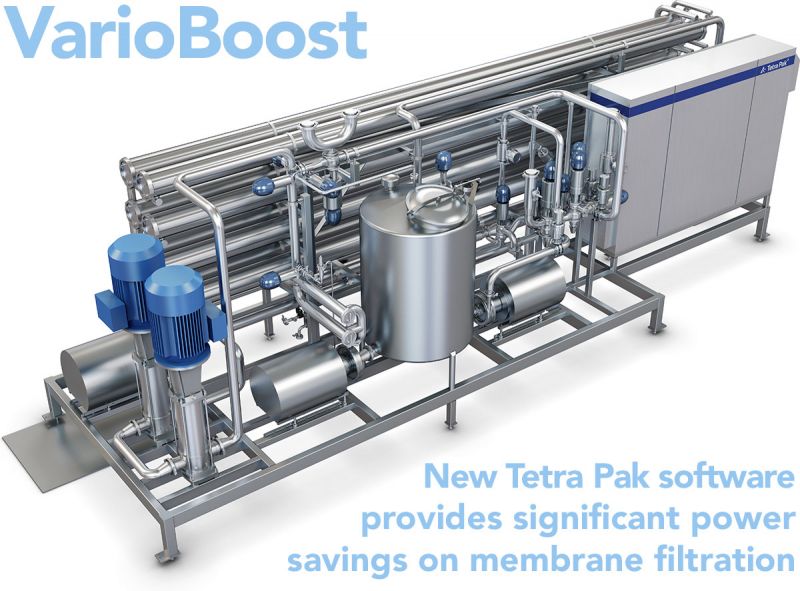New Software Provides Significant Power Savings on Membrane Filtration
Published on by Water Network Research, Official research team of The Water Network in Technology
The new Tetra Pak software has been developed to optimize the speed control of the booster pumps automatically, thereby achieving up to 65 % power savings. Patent pending.
The software, which has been tested in cooperation with customers, helps the booster pumps run at the lowest possible speed without changing the performance of the membrane filtration plant. As a result, the need for cooling is also reduced, adding to the power saving. Combined with Tetra Pak’s water-saving solutions, the company offers state-of-the-art membrane filtration solutions that support customer requirements for cost reduction and sustainability.

In addition to the significant power savings, the intelligent software ensures longer membrane life and lower risk of telescoping of membranes, as the flow over the membranes is reduced during production.
“Membrane filtration has always required much power. With the new software, we take a major step towards a more sustainable solution. Intelligent control of the process reduces the cost of operation and carbon footprint and thus contribute positively to environmentally conscious branding of food producers,” says Karsten Lauritzen, Director Business Development, Tetra Pak Filtration Solutions.
Filtration is already a sustainable solution when it comes to filtration of milk, cheese milk, and whey as the raw materials can be completely exploited. Both when it comes to removing bacteria that ensure the products longer shelf life, as well as by concentrating milk and whey, where water is removed from the products and can be used for fx process water or for cleaning production plants instead of discharging it as wastewater. Combined with the ability to concentrate and precisely fractionate proteins so that customers can create exactly the products they want, membrane filtration is a game-changer for the dairy industry.
VarioBoost is an integral part of all new Tetra Pak membrane filtration plants – and can be integrated with existing plants.
The patent on the software is pending.
FACTS
In a membrane filtration plant, the plant is fed with a product, and the product is recirculated over the membranes with booster pumps. The function of the booster pumps is to make a continuous filtration process possible. A membrane filtration plant can consist of a single loop or many loops depending on the capacity of the plant.
There are two methods for controlling the booster pumps – the new one with loop pressure drop control, the other with a constant speed of booster pump. The new method using loop pressure drop control regulates the speed of the booster pump so that the pressure drop over the membrane is adjusted to the desired level. The traditional method using constant booster pump speed is set via a fixed set point indicating the speed of the booster pump so that a loop pressure drop is achieved.
Membrane filtration
Since the Danish Sugar Factories began experimenting with membrane filtration in the 1960s, the technology has undergone rapid development. Today, technology is an integral part of many dairy processes because it can precisely separate the milk components, thus offering the dairies opportunities to combine them into new products and expand their markets.
Lactose-free milk, cost-efficient production of skyr, concentrated yogurt, feta cheese, and a wide range of ingredients have seen the light of day due to membrane filtration. And the development continues.
We are going to see even more specialty products, e.g. with increased protein content, and further refinement of ingredients for the food industry based on whey and milk, which is Tetra Pak Filtration’s core business – and a fast-growing market. Also, filtrating of plant-based foods and beverages such as oat milk is part of competencies.
In-house Water Competence Center
The dairy industry is a heavy user of water. The old, small dairies, which in most cases are history now, were located close to streams for easy access to freshwater and drainage of sewage. However, as dairies grow and are challenged by more environmental requirements, focus on sustainability is increasing.
Milk consists of 87 % water, and the Nordic dairies are now good at exploiting the surplus water they generate. Worldwide, however, there are untapped opportunities for saving water; especially in countries where the cost of drinking water and wastewater is high.
Food safety legislation in relation to water recycling in the production is, however, a challenge in many countries, as the legislation has not kept up with technological development. Therefore, we have established a water competence center, which focuses on servicing our customers with sustainable solutions, an important part of which is optimizing water consumption.
Media
Taxonomy
- Membrane Bioreactor Systems
- Filtration
- Filters
- Filtration Solutions
- Membrane Technology
- Membrane Filtration
- Filtration
- Brewing and Membrane Filtration
- Dairy Products
- Dairy
- Membrane distillation
- Membrane